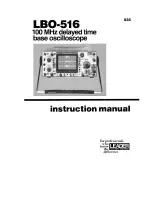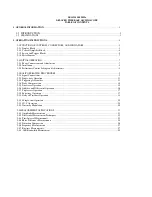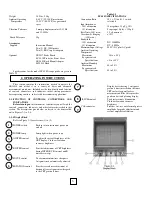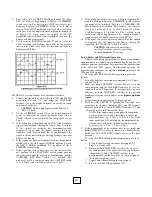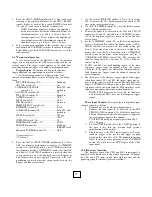
Weight 20.9 lbs, 9.5 kg
Ambient Operating 0-40°C (32-104°F) maximum
Temperature 15-35°C (60-95°F) for guaranteed
specs
Vibration Tolerance 2 mmp-p displacement at 12-33 Hz
and 33-35 Hz
Shock Tolerance 30g
Accessories
Supplied Instruction Manual
Two (2) LP- 100X probes
Two (2) BNC-to-post adaptors
Optional LP-2017 Probe Pouch
LC-2016 Protective Front Cover
LR-2402 Rack Mount Adaptor
LH-2015 Hood
Specifications for the model LP-100X scope probe are given in
Table 1-2.
This section contains the information needed to operate the
LBO-516 and utilize it in a variety of basic and advanced
measurement procedures. Included are the identification and function
of controls, connectors, and indicators, initial startup procedures,
basic operating routines, and selected measurement applications.
2-1. FUNCTION OF CONTROLS, CONNECTORS, AND
INDICATORS
Before turning on
this instrument, familiarize yourself with the
controls, connectors, indicators, and other features described in this
section. The descriptions given below are keyed to the items called
out in Figures 2-1 to 2-4.
2-1-1 Display Block
Refer to Figure 2-1 for reference (1) to (9).
POWER switch Push in to turn instrument power on
and off
POWER lamp Lamp lights when power is on
A INTEN control To adjust the overall brightness of the
CRT display. Clockwise rotation
increases brightness
B INTEN control Provides adjustment of CRT brightness
during INTEN BY B interval and B
timebase sweeps
FOCUS control To attain maximum trace sharpness.
Astigmatism is automatically adjusted.
ROTATION control Provides screwdriver adjustment of
horizontal trace alignment with regard
to the CRT graticule lines
Table 1-2
LP-100X SPECIFICATIONS
Attenuation Ratio 10:1 +-2% and 1:1, switch
selectable
Input Impedance
10X attenuation 10 megohms, 12 pF + 10%
1X attenuation Scope input Z plus < 150 pF
Rise Time (10X atten.) 3.5
K
S nominal
Overshoot & Ringing <10%
(10X atten.)
Bandwidth
10X attenuation DC- 100MHz
1X attenuation DC - 6 MHz
Maximum Input Voltage 600 V (DC plus AC peak)
Ambient Operating
Temperature
Maximum - 10 to + 55°C
For guaranteed
Specifications +5 to +35°C
Ambient Humidity
Maximum 40 to 90%
For guaranteed
Specifications 45 to 85%
CRT Display device having 1 cm square
graticule lines inscribed on the inner
CRT surface for parallax-free
measurements. Blue filter provides
good contrast and pleasing display.
ILLUM control To adjust graticule illumination.
Clockwise rotation increases
brightness
CAL connector Provides fast-rise waveform of precise
amplitude for probe adjustment and
vertical amplifier calibration.
2. OPERATING INSTRUCTIONS
1
2
3
4
5
6
7
8
9
3

